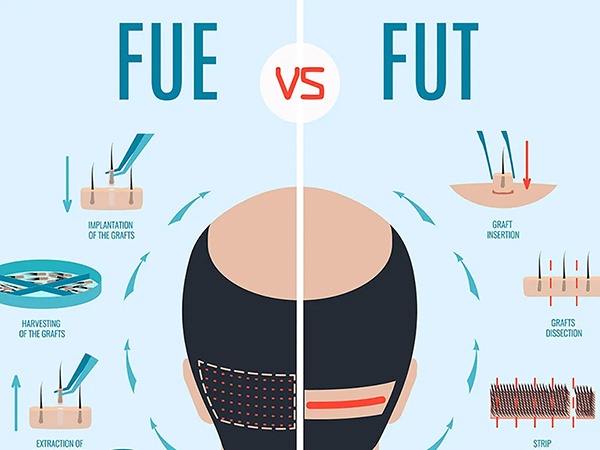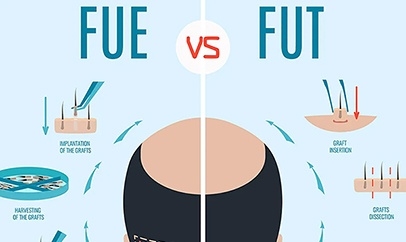
Going bald so suddenly is devastating. After years with your precious locks, you will have difficulty getting used to having no hair in some areas or your whole head. And it is not just for the older generation either; younger people are balding as early as 25 years old. Furthermore, while it is more severe in males, a good population of females also experience balding.
This regular occurrence due to genes and other factors often does nothing for self-esteem. However, it is not the end of the world, as you can quickly correct this with a hair transplant procedure. Many people undergo hair transplant procedures every day. This bold move helps with baldness, and you can quickly restore your fallen locks in a matter of months. And luckily, there are many procedures available to you.
FUE and FUT Procedures
When you research or talk about hair transplant procedures, you will come across FUE and FUT procedures. These two are the most common hair transplant procedures, and each has its unique process, resulting in strengths and shortcomings. To select the best method for your situation, first, you must learn about these procedures.
1. Follicular Unit Transplantation (FUT) Hair Transplant
In this method, the surgeon will extract a linear strip of the scalp from the donor area hence its name ‘the strip method.’ This is often done at the back of the scalp. But it can be anywhere where the hair is not thinning as much. The surgeon will then dissect the strip into multiple follicular grafts, anything from 500 to 2000 grafts. The physician does this through stereo-microscopic dissection. Once the surgeon gains enough follicles, they will close the wound leaving a single fine line scar. The physician will insert the grafts into the balding area through tiny incisions. The FUT procedure comes with many advantages, including:
Coverage for a large area. The initial graft yields many grafts after dissection and will cover a larger area requiring transplants.
- Single scar. The entire procedure will leave a single scar from the donor area.
- Minimal shaving. The procedure does not require extensive shaving of the donor area, so you will not see a considerable difference after surgery in the area.
- Fuller results. Each graft has 1 to 4 strands which means you will get fuller results when the hair grows.
- Shorter time. Removing the hair strip takes a short time as it comes out as one strip instead of individual follicles.
However, some patients refuse this form of hair transplant procedure due to the following shortcomings:
- Longer recovery time. It takes about 10 to 12 days to recover from the procedure, and if you are on a tight routine, this can be a considerable disadvantage.
- Noticeable scar. Unfortunately, the procedure leaves a visible scar, even with modern sewing techniques. However, this is only if you choose to wear your hair extremely short. The scar is not a problem if you wear your hair long.
2. Follicular Unit Extraction (FUE) Hair Transplant
This technique is more modern and sees a surgeon harvesting hair follicles from a donor area with sufficient hair growth. The surgeon will harvest the follicles through microscopic circular incisions.
Alternatively, the surgeon can use a robotic hair transplant device to harvest the hair follicles. The physician then transplants the strands into the areas with thinning or baldness. The harvesting and transplanting are minimally invasive. It leaves tiny incision marks, but they heal, and your new hair will conceal any scarring. Patients choose this procedure because:
- Natural-looking results. When the hair grows, it has a natural appearance, and you can even wear the hair as short as you like as scarring is not visible. And because of harvesting, the hair will match the color and thickens of other areas enhancing the natural look.
- Quick recovery. Because the FUE process does not require any skin grafting or stitches, it has a short recovery time. Many people go back to routines just a few days after the surgery.
- Minimal scarring. The scars from FUE procedures are minute and scattered around the donor area. You and others will barely notice them, and after hair growth, nobody will.
- Painless. The process uses local anesthesia to reduce discomfort throughout the procedure. Most patients do not feel any pain during the procedure, and the pain is very minimal afterward.
However, the FUE procedure is not without shortcomings that make it unfavorable to some patients. These include:
- Time-consuming. Extracting the grafts is a time-consuming process, even with the help of robotics. This is because the physician extracts individual follicles. This will take some time, and if you have a large area to cover, it will take a few days to complete.
- Costly. Also, this procedure is not cheap. Because of extracting grafts and high-quality results, this procedure is more expensive than other transplant methods; therefore, not suitable for those on a budget.
Which Procedure Is Best For Me?
Selecting the best procedure is all about your situation and budget. First, if you are on a limited budget, then the FUT procedure is the best option. It is less costly and will give you great results without spending too much above your budget. It costs between $4,000 and $10,000, while an FUE procedure costs between $4,000 and $15,000. These processes vary according to how much area requires transplants and the institution offering the procedure.
As for the situation, you are better off with FUT if you need to cover a larger area. Since it produces more grafts with just a single strip of harvested follicles, you can cover a wider area. However, if your balding is restricted to a small area, you are better off with FUE to prevent wasting grafts.
FUE is also better for people in the onset stages of balding, about 1 to 7 years, while FUT is better for those who have passed this stage. Finally, because of the scar it leaves on the donor area, FUT is better for people who don’t mind wearing their hair long. It covers up the scar better. FUE allows you to wear your hair shorter due to minimal scarring.


